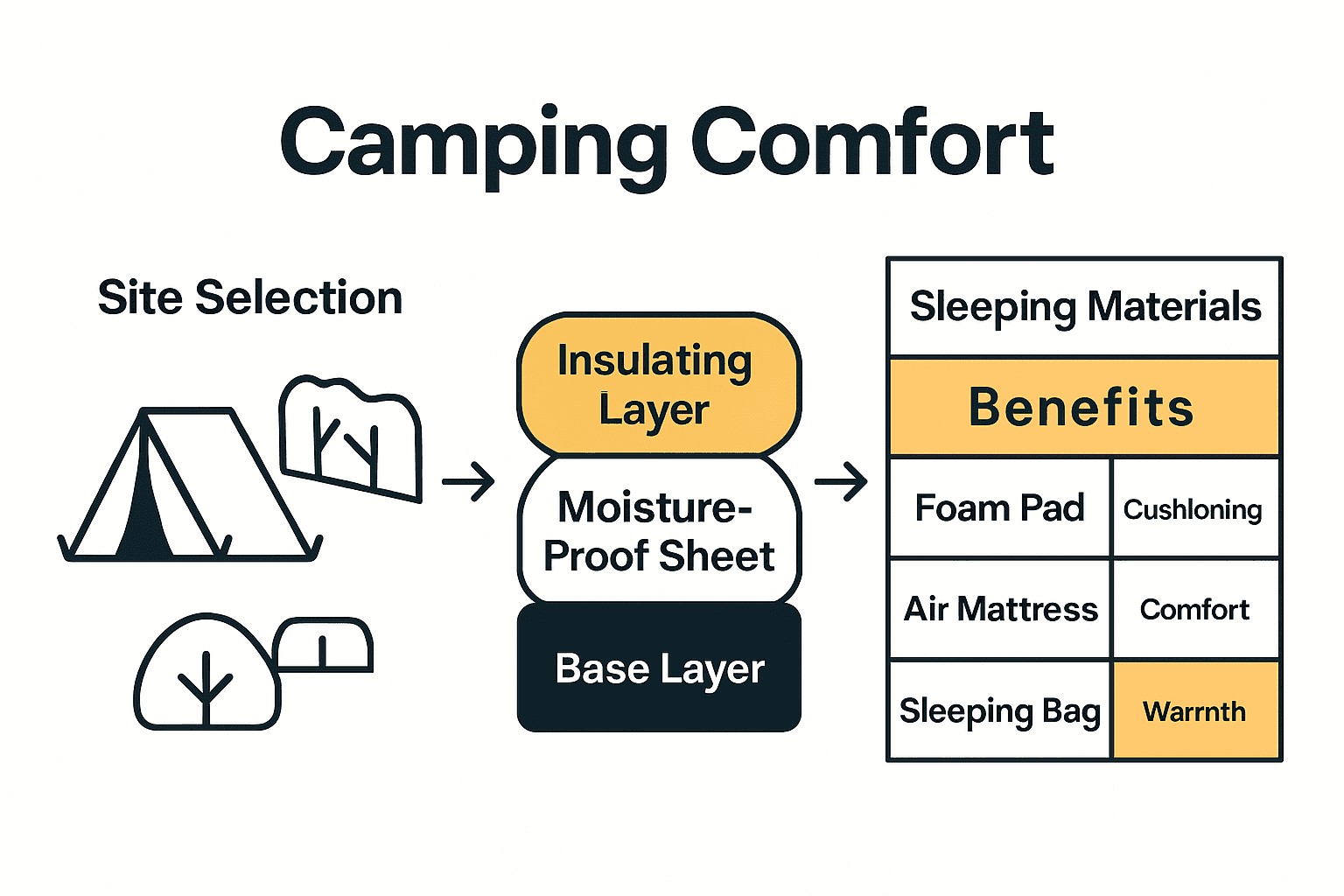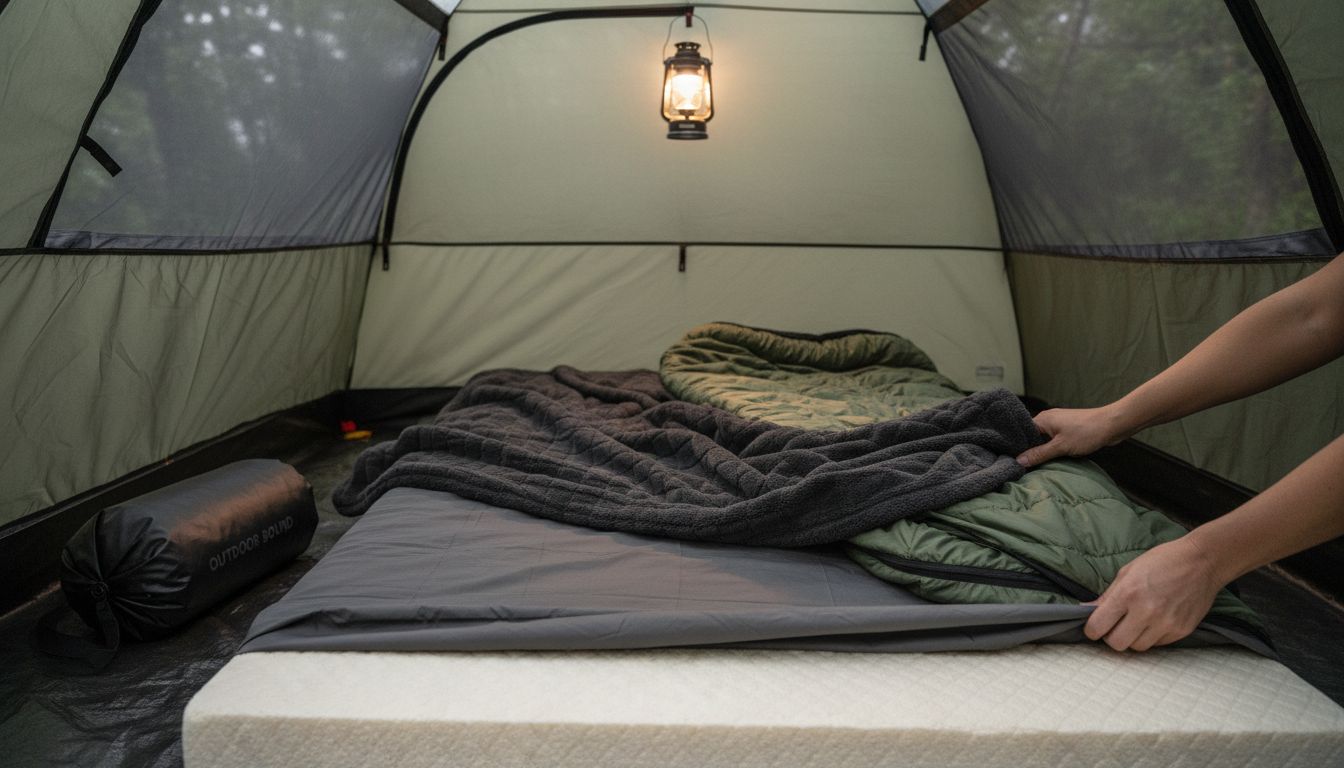Overnight lows during camping trips can drop by more than 20 degrees in just a few hours. Staying warm and comfortable outside is not just about bringing a sleeping bag. Smart campers know that everything from site selection to moisture management can make or break your night’s rest. Whether you camp for adventure or for peace and quiet, learning these practical strategies helps you avoid shivering and wake up ready for the day ahead.
Table of Contents
- Step 1: Assess Overnight Weather And Ground Conditions
- Step 2: Select The Right Base Layer And Mattress
- Step 3: Add Insulating Layers For Optimal Warmth
- Step 4: Incorporate Moisture-Proof And Breathable Sheets
- Step 5: Test And Adjust Your Sleeping Setup On-Site
Quick Summary
| Key Point | Explanation |
|---|---|
| 1. Choose a suitable campsite | Evaluate terrain for hazards like flooding, and use natural windbreaks for comfort. |
| 2. Select proper base layers | Choose lightweight, midweight, or heavyweight fabrics based on temperature to regulate body heat effectively. |
| 3. Utilize insulating layers | Focus on breathable materials that trap heat while enabling moisture escape, adapting to changing weather. |
| 4. Pick moisture-proof sheets | Use sheets that wick moisture away and dry quickly to maintain a comfortable sleeping environment. |
| 5. Test your setup on-site | After setting up, assess your sleeping arrangements for comfort and adjust based on environmental conditions. |
Step 1: Assess Overnight Weather and Ground Conditions
Choosing the right camping location requires careful evaluation of weather and ground conditions. Your goal is to find a safe spot that provides comfort and protection for a restful night outdoors. According to wintercampers, selecting a suitable campsite involves analyzing several critical factors.
First, survey the terrain for potential hazards. Look for a level area away from potential risks like dead tree branches or slopes that might collect water. Avoid setting up camp at the base of hills where flooding could occur or near water sources that attract insects. As outwardbounders recommends, utilize natural windbreaks such as trees or rock formations to minimize wind exposure and stabilize your sleeping environment.
Consider the direction of your campsite. Positioning your tent facing east can help capture early morning sunlight, providing natural warmth when you wake up. Check local weather forecasts to anticipate temperature changes and potential precipitation. Bring appropriate ground coverings like waterproof tarps or specialized camping mats to create an insulating barrier between your sleeping area and potentially damp ground. Your comfort starts with smart site selection and preparation.
Step 2: Select the Right Base Layer and Mattress
Selecting the perfect base layer and mattress is crucial for achieving optimal comfort during outdoor sleeping experiences. Your clothing and sleeping surface work together to regulate body temperature and provide essential support throughout the night. The Adventure Junkies provides expert guidance on choosing base layers that match your specific camping conditions.
When selecting a base layer, consider the weight based on expected temperatures. Lightweight fabrics are ideal for mild to cool conditions because they wick moisture quickly and dry fast. Midweight layers work well as standalone pieces in cooler environments or as part of a layering system. For extremely cold nights, opt for heavyweight base layers that provide additional insulation. Your mattress selection is equally important for comfort. As highlighted by UNLV, look for self-inflating options with features like a compressible foam core and adequate thickness to provide warmth and support.
Pro tip: Always pack an extra base layer and check your mattress inflation before setting up camp. This preparation ensures you can adapt to unexpected temperature changes and have a reliable sleeping surface. Choose a mattress with at least 2 inches of thickness to guarantee proper insulation and comfort during your outdoor adventure.

Step 3: Add Insulating Layers for Optimal Warmth
Layering effectively is your key strategy for maintaining body temperature and comfort during outdoor sleeping adventures. Understanding the science of layering can transform your camping experience from cold and uncomfortable to warm and enjoyable. According to Girl Guides, successful outdoor clothing follows the “3 Ws” principle of layering: Wicking, Warmth, and Wind protection.
Your insulating layer should focus on trapping heat while allowing moisture to escape. Mid layers like polar fleece or wool sweaters provide exceptional warmth without excessive weight. The Adventure Junkies recommends creating a layering system that allows flexibility based on changing weather conditions. Choose materials that offer thermal regulation and can be easily added or removed as temperatures fluctuate.
Pro tip: When selecting insulating layers, prioritize breathability and compressibility. Explore different camping blanket options to supplement your layering strategy and ensure you have backup warmth for unexpected temperature drops. Remember that proper layering is about creating a versatile system that adapts to your body and environment.

Step 4: Incorporate Moisture-Proof and Breathable Sheets
Creating the perfect sleeping environment starts with selecting sheets that manage moisture and provide optimal comfort during your outdoor adventures. The Adventure Junkies emphasizes the critical importance of choosing materials that are both moisture-proof and breathable to maintain a comfortable sleeping experience.
When selecting sheets for camping, prioritize fabrics that actively wick moisture away from your body. Synthetic materials like microfiber or specialized outdoor fabrics work best for managing perspiration and preventing that uncomfortable damp feeling. According to Girl Guides, staying dry is crucial to maintaining body temperature and overall comfort during outdoor activities. Look for sheets with quick-drying properties and moisture-wicking capabilities that can help regulate your body temperature throughout the night.
Pro tip: Explore various outdoor sleeping arrangement ideas to complement your moisture-managing sheet strategy. Consider packing an extra set of sheets and storing them in a waterproof bag to ensure you always have a dry option available. Remember that your sleeping comfort depends on preparation and the right technical materials.
Step 5: Test and Adjust Your Sleeping Setup On-Site
Preparing for a comfortable night outdoors requires more than just packing the right gear you need to fine tune your sleeping setup on location. Winter Campers recommends carefully testing your entire sleeping system immediately after setting up camp to identify and address potential comfort issues before nightfall.
Start by thoroughly examining your sleeping area and testing each component of your setup. Lay out your sleeping pad and test its positioning and insulation properties. Check for uneven ground or potential drafts that might compromise your warmth. According to Outward Bounders, taking time to lie down and assess your sleeping arrangement can reveal important adjustments needed to maximize comfort. This might include repositioning your tent to block wind angles or adding an extra layer of insulation beneath your sleeping pad.
Pro tip: Explore our guide on improving camp sleep naturally to supplement your on site testing strategy. Always pack versatile gear that allows quick adjustments and be prepared to modify your setup as environmental conditions change. Your goal is creating a flexible sleeping system that adapts to the unique challenges of outdoor sleeping.
Sleep Soundly Outdoors With Expert Layering and Comfort Gear
Camping sleep challenges like staying warm and comfortable demand smart solutions. This article’s focus on layering strategies and moisture control pinpoints real pain points you face while trying to rest well outdoors. You understand how crucial it is to combine insulating layers, moisture-proof sheets, and the right mattress thickness to maintain warmth and comfort under changing conditions.
At Hazli Collection, we share your commitment to top-tier outdoor sleep comfort. Our high-quality memory foam mattresses and camping gear are designed to complement your careful layering approach by providing lasting support and insulation. Imagine waking up refreshed after a night on a mattress optimized for outdoor conditions paired with your well-chosen layers.
Looking to enhance your outdoor sleep setup now?

Discover our premium selection at Hazli Collection and equip yourself with gear that adapts perfectly to your layering system. Visit Hazli Collection today to find dependable mattresses, moisture-wicking sheets, and accessories that fit your outdoor adventure needs. Don’t wait for discomfort to sneak in — improve your camping nights and embrace restful sleep with trusted solutions designed just for you.
Frequently Asked Questions
How do I assess weather conditions before camping?
To assess weather conditions effectively, check the local forecast for temperature changes and potential precipitation. Make sure to analyze the terrain for hazards and choose a campsite that offers natural protection against wind and moisture.
What should I consider when selecting a base layer for camping?
When selecting a base layer, consider the expected temperatures and choose lightweight fabrics for mild conditions or heavyweight options for extreme cold. Ensure your base layer wicks moisture and dries quickly to maintain comfort throughout the night.
How can I create an effective insulation layer while camping?
To create an effective insulation layer, use mid-layer items like fleece or wool that trap heat while allowing moisture to escape. Develop a versatile layering system that lets you adjust your clothing based on changing weather, ensuring comfort all night.
What types of sheets are best for outdoor sleeping arrangements?
The best sheets for outdoor sleeping arrangements are those made from moisture-proof and breathable materials that wick sweat away from your body. Look for quick-drying fabrics to help regulate your body temperature and maintain comfort during your camping sleep.
How can I test my sleeping setup to ensure maximum comfort?
To test your sleeping setup, lay down on your pad immediately after setting up camp and check for comfort issues like uneven ground or drafts. Make necessary adjustments before nightfall to enhance your overall sleeping experience, such as repositioning your tent or adding extra insulation.
What additional gear should I pack for an adaptable sleeping setup?
Pack versatile items like extra base layers, compressible insulation, and moisture-managing sheets to create an adaptable sleeping setup. Prepare to adjust your arrangement based on environmental changes to stay comfortable and warm through the night.
Recommended
- 7 Essential Camping Comfort Tips for a Restful Outdoor Stay – Hazli Collection
- How to Improve Camp Sleep Naturally for Outdoor Comfort – Hazli Collection
- 7 Outdoor Sleeping Arrangement Ideas for Ultimate Comfort – Hazli Collection
- 7 Essential Outdoor Sleep Solutions List for Comfort – Hazli Collection

